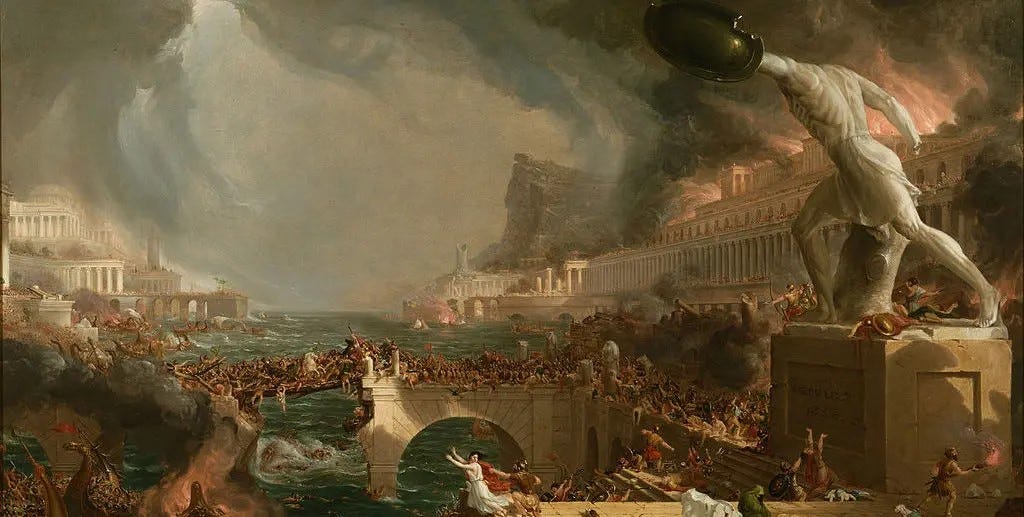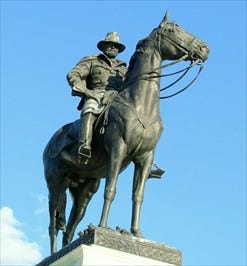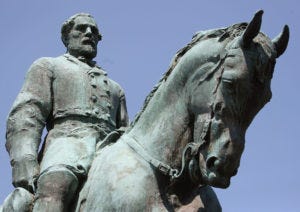In the Culture War, Culture Is Losing
Instead of competing by creating new art and culture, both the left and right are simply trying to wipe each other out

There is an old doctrine originally attributed to the medieval Catholic Church: Error non habet ius—“Error has no rights.” It is particularly associated with the “Syllabus of Errors,” Pope Pius IX’s 1864 broadside against political liberalism, freedom of conscience and the separation of church and state. The argument is that the common good requires the suppression of false ideas that might lead people into error. I mean, if an idea is wrong, how can it claim any right to be tolerated?
This view had already been undermined by less dogmatic thinkers like the American Catholic Orestes Brownson, who coined the rejoinder, “Error has no rights, but the man who errs has equal rights with him who errs not.” The whole doctrine was ultimately abandoned in the Second Vatican Council with the backing of Bishop Karol Wojtyla, the future Pope John Paul II.
Yet somehow “error has no rights” has ended up being the ruling principle of both sides in our current culture war.
‘A State-Run Monopoly’
That the current “woke” ideology of the left is totalizing and intolerant is obvious. But consider the reaction to it on the right, which has taken the form of attempting to impose a countervailing set of speech codes for public schools. A few of us on the right, including David French—who spent a career as a litigator protecting conservatives from campus speech codes—have rightly called this an illiberal solution to an illiberal problem.
In answer, the Manhattan Institute’s Christopher Rufo offers the following argument in favor of vigorous government action to stop the propagation of the error of critical race theory.
These authors may imagine themselves to be defending liberal-democratic freedoms against the threat of illiberalism. But in practice, they enable, and would leave American families defenseless against, the worst ideologies of the Left. They advance three specious arguments—that critical-race-theory restrictions violate free speech, that state legislatures should stay out of the marketplace of ideas, and that citizens should pursue civil rights litigation instead—that would serve to usher in the concrete tyrannies of critical race theory, which explicitly seeks to subvert the principles of individual rights and equal protection under the law. Despite the superficial differences among the four heterodox authors, they all serve a single function: to prevaricate, stall, and run interference for critical race theory’s blitz through American institutions. …
French understands that critical race theory is a totalitarian ideology that, if it were to achieve absolute power, would immediately dismantle liberalism, beginning with the right to free speech. But he and his coauthors neglect the obvious question. If critical race theory is ‘racial poison,’ why allow it to seize control of our schools? If critical race theorists are ‘magnetic, preacher-like personalities’ who seek totalitarian power, why defend their pursuit of this power in the name of liberalism?
The argument Rufo is making is one that has gotten a lot of traction on the right in recent years. Feeling under siege, conservatives have fallen for the rationalization that a liberal political order has to be defended by illiberal means. We have to burn down a free society in order to save it—and anything less than this is denounced as weak-willed, unilateral disarmament against the left.
Notice that Rufo is not arguing that French has drawn the line in the wrong place when it comes to what are acceptable measures against political indoctrination in the schools. Instead, the thrust of Rufo’s argument is to reject all lines and all limits, so that anyone wanting to assert such limits is thereby on the side of error and is guilty of defending it. It is an updated version of the idea that error has no rights.
But if we ban the teaching of critical race theory, what exactly are we banning? Rufo himself has admitted how broad his goals are, explaining that he uses “critical race theory” as a propaganda tool for a wider agenda.
We have successfully frozen their brand—‘critical race theory’—into the public conversation and are steadily driving up negative perceptions. We will eventually turn it toxic, as we put all of the various cultural insanities under that brand category.
This talk about “freezing” the target reminds me of Saul Alinsky—the rabble-rousing, left-wing activist whose “Rules for Radicals” has become a touchstone for the right in recent years—on the theory that the only way to fight the left is to adopt their worst tactics.
So, if the goal is to stop “all of the various cultural insanities,” what is to prevent teachers from introducing much of the same content, just in a slightly different form or under a different name? The only way to stop it is through surveillance, which is precisely what Tucker Carlson has proposed.
Well, we can’t really be sure until we finally get cameras in the classroom, as we put them on the chests of police officers. Until we finally [put] a civilian review board in every town in America to oversee the people teaching your kids, forming their minds. Until we do, we can’t know exactly how widespread this is.
We’re going to save freedom by creating an educational police state.
Or consider Rich Lowry of the “National Review,” who declares that “The point of the anti-CRT fight should be to take over the schools.” Rufo is even clearer about this: “[T]he public education system is not a ‘marketplace of ideas’ but a state-run monopoly.... [I]n a democracy, voters get to decide how to shape, guide, and restrict public institutions, especially those that have power over children.”
The fact that public schools are a state-run monopoly is precisely why they pose free-speech dilemmas that require a delicate balancing act to ensure that schools are, as far as possible, politically neutral and focused only on the objective requirements of education. But why try to limit (or even break up) the state’s monopoly on education when you can seize it for your own ends?
But can you seize it? Conservatives are engaging in these fantasies of political control over education because they feel besieged by an increasingly dominant secular culture. Yet they show no awareness of the risk that, precisely because they are no longer the majority, every control they put in place, every protection they knock down, is building more state power that will eventually be used against them.
If error has no rights, that bodes poorly for conservatives when they are the ones who are considered to be in error.
Erring Reason Binds
Consider the fate of error in recent days in Charlottesville, which finally got around to removing its statues of Confederate generals—and then some. There had been a long battle over the monuments to Confederate commanders Stonewall Jackson and Robert E. Lee, but at the last minute, the City Council held an emergency meeting—because apparently the existence of politically incorrect art is an “emergency”—to also remove a sculpture of Lewis and Clark.
At the same time, the University of Virginia removed its statue of George Rogers Clark, a local Revolutionary War hero. Why? George Rogers Clark fought against the British in the Northwest Territories (what is now the Midwest), and the sculpture shows him accepting the surrender of a Native American chieftain allied to the British. Similarly, the Lewis and Clark statue includes their native guide Sacagawea—one of the first to do so—but portrays her in an insufficiently heroic pose. This is third-rate art criticism masquerading as a political cause.
It is as if activists set out to validate the “slippery slope” argument, demonstrating that the battle over Confederate monuments is not about slavery or the Civil War, but is part of a general purge of American history. Yet the actual common premise is that error has no rights.
As a transplanted Midwesterner, I have no particular love for Stonewall Jackson, who was not merely a Confederate general but also a pro-slavery fanatic, and I have never quite understood the near-hagiographic reverence with which he used to be regarded in Virginia. But Robert E. Lee strikes me as something of a litmus test for the rights of error. He is universally regarded as an otherwise good man who fought for a wrong cause, and it is probably a good thing for the country to preserve some kind of public recognition that such a thing can happen. This is, after all, how we maintain a sense of civility in a diverse and ideologically divided society, by making some allowance for the dignity of those who end up on the losing side of even our bitterest conflicts.
The answer to the medieval principle that error has no rights is another, opposite medieval idea: that “erring reason binds,” that there is nobility in following one’s conscience even when it is mistaken.
This is actually consistent with the theme of Charlottesville’s recently removed statue of Lee. It is not widely known—because the key to this whole enterprise is to evaluate art by reference to nothing other than contemporary politics—but the Lee statue was a sort of answer to another work by the same artist, New York sculptor Henry Shrady. Its counterpart is the earlier Ulysses S. Grant Memorial in Washington, D.C., which stands at the foot of Capitol Hill.
If you look closely, you can notice how the two sculptures present variations on a theme. Grant is portrayed with his hat on and his hand on his hip, looking resolutely forward, which is echoed in the raised, alert head of his horse. Lee is portrayed with his hat off and held down to his side, his brow furrowed and his eyes downcast, his horse’s head lowered. The two sculptures were created within a decade or so of each other in the early years of the 20th century, and the significance of these artistic choices would certainly not have been lost in what was still a hat-wearing and horse-riding culture. Grant is portrayed as a dignified victor, and the theme of Shrady’s portrayal of Lee is dignity in defeat.

But no one is in the mood for such a subtle analysis, nor for understanding art on its own terms rather than as a political football.
Notice the similarity in the reasoning between the right and the left on this, as summed up by a University of Virginia student interviewed by The Washington Post, who admits that all he knows of George Rogers Clark is what was on the statue’s plaque. As Akhil Rekulapelli, a fourth-year undergrad, told the Post: “If any group feels oppressed or doesn’t feel welcome” because of a statue, that statue should be taken down. “Universities are kind of these cathedrals of knowledge, and it’s so important that we don’t push people away.”
To preserve the “cathedral of knowledge,” we have to eliminate anything in it that might offend anybody’s feelings. It’s the same “burn down the village in order to save it” mentality.
Is Culture Winning or Losing?
What is disturbing about the removal of these sculptures is the way that it feeds not a desire to understand, but a lust to destroy. My social media feeds recently have been full of local friends and acquaintances eager to pat themselves on the back for their support of the sculpture removals. It’s an easy path to virtue, but also a dark one.
While watching these sculptures come down all across town and driving by the stubs of their plinths the next day, I was reminded of ancient ruins of past civilizations. I just happen to be in the middle of reading Catherine Nixey’s 2017 book “The Darkening Age,” about the early Christian campaign to destroy the temples, sculptures and books of the Classical world. Well, it’s not a complete coincidence because there is a very distinct parallel. Like the ancient Christian fanatics, we are measuring the triumph of virtue not by what we create, but by what we destroy.
Think about that when you listen to Rose Ann Abrahamson, supposedly representing the Native American perspective, talking about the Lewis and Clark statue: “I feel that it should just be melted down.... I feel that it’s entirely offensive, and it should be obliterated.”
The abandoned plinths (which will eventually be removed in their turn) leave the entire town of Charlottesville without any public figurative art, with nothing to say about its own history one way or another. The remaining public art in this town tends to be indecipherable and undistinguished contemporary art or a handful of mostly propagandistic murals—though you can see how hard it is to create anything when it has to undergo such a withering political inquisition. As Nixey points out, the Romans were induced to destroy much of their own art before the barbarians got around to sacking them, and we are now doing the same.
My longstanding prescription for the end of the culture war is that culture wins. It is healthy that people have different visions of what the culture should be—so long as they compete by creating stories, art and architecture intended to showcase what their vision has to offer the world. But the culture war becomes pathological when it is about the books you can ban, the intellectuals you can cancel, the ideas to be legislated against and the statues to be torn down.
Right now, the two sides of the culture war are fighting furiously to wipe each other out—and culture is losing.




